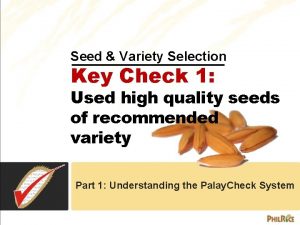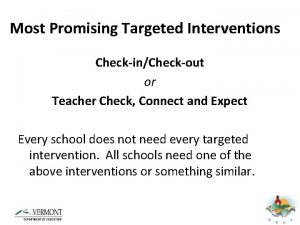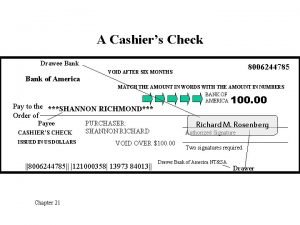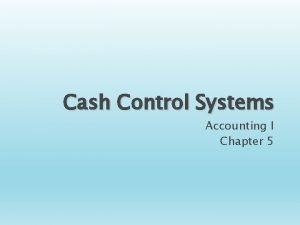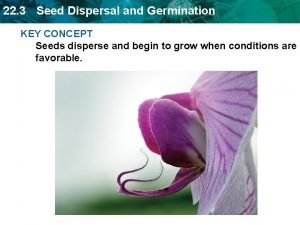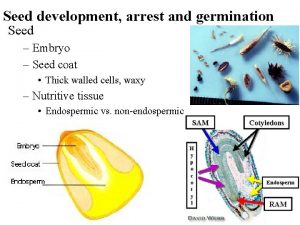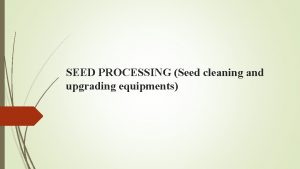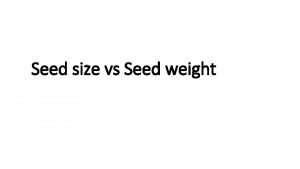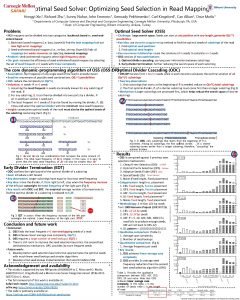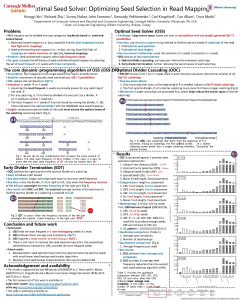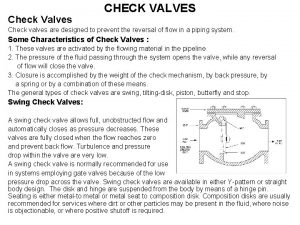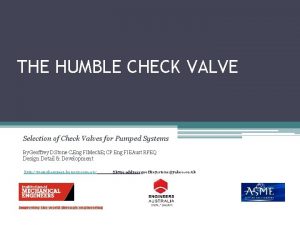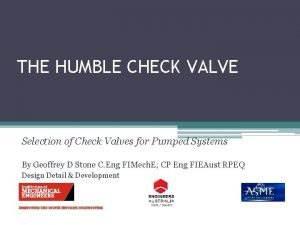Seed Variety Selection Key Check 1 Used high
































- Slides: 32

Seed & Variety Selection Key Check 1: Used high quality seeds of recommended variety Part 1: Understanding the Palay. Check System

Seeds are the foundation of farming. You reap what you sow! SOW high quality seed (+ good production practices) = REAP high quality harvest

What are high quality seeds? Why use high quality seeds?

High Quality Seeds High Quality relatively pure Poor viable fewer weed seeds full & uniform in size free from seedborne pests & diseases

Which field used high quality seeds?

Classes of High Quality Seeds BREEDER seeds are produced by Phil. Rice from uniform panicles (nucleus seeds). FOUNDATION seeds are grown by Phil. Rice & Seed. Net from breeder seeds. REGISTERED seeds are grown by Seed. Net & selected seed growers from foundation seeds. CERTIFIED seeds are grown by seed growers from registered seeds. These are sold to farmers.

Philippine Laboratory Standards for Seed Certification Factor BS FS RS CS Pure seed (%) 99 98 98 98 Other varieties (grains/500 g) 0 2 5 20 Weeds/Other crops’ seeds (%) Inert matter (%) 0 0 0. 05 0. 1 1 2 2 2 Red rice (grains/500 g) 0 0 1 2 Germination (% min) 85 85 Moisture Not content (%) 100% pure! 14 14

Farmers may also produce their own high quality seeds!

Importance of Key Check 1 When high quality seeds are used: Less pest problems More efficient crop establishment activities Lower seed rate but more vigorous & more uniform crop germination 10 -15% yield increase More efficient harvesting activities

Why use recommended varieties? Recommended varieties are adapted to local conditions: • • appropriate to the environment • have produced relatively stable & high yield in adaptability trials • acceptable to farmers & demanded by the local market resistant to pests & abiotic stresses (e. g. drought, flood) in the locality

TRIVIA on Varieties 1. PSB Rc means Philippine Seed Board Rice while NSIC means National Seed Industry Council. The NSIC, which used to be the PSB, approves the release of new varieties. 2. Odd-numbered varieties (PSB Rc 1) are for the upland environment while even-numbered varieties (NSIC Rc 216) are for the irrigated lowland environment. 3. Glutinous varieties are also odd-numbered.

TRIVIA on Varieties 4. Until 2001, lowland rice varieties are named after rivers (Pagsanjan, PSB Rc 10) while upland rice varieties are named after mountains (Apo, NSIC Rc 9). Now, naming is as follows: Inbred – Tubigan Saline-prone - Salinas Hybrid – Glutinous - Malagkit Mestiso Aromatic- Mabango Upland varieties Flood-prone – – Katihan Submarino Rainfed - Sahod-ulan Tungro-resistant Cool-elevated Matatag

Assessment of Key Check 1 § Seeds are certified by the National Seed Quality Control Services (i. e. if certified seeds, a blue tag is attached) or sourced from reliable sources (i. e. Phil. Rice, accredited seed growers) § If seeds are old stocks; a carry-over from previous season; or farmer-produced, then these should have passed germination or seed test.

Assessment of Key Check 1 § The variety suits the environment (e. g. irrigated, rainfed, saline-prone, etc); addresses a prevailing local field problem (e. g. tungro-resistant); OR has performed well in at least two seasons of adaptability trial (ask Phil. Rice, local DA office). Mestiso 20 (NSIC Rc 204 H) • recommended for DS & WS in Nueva Ecija, Isabela, Cagayan, Davao del Sur & del Norte, General Santos, Bukidnon, and similar areas

Recommendations to Achieve Key Check 1 § Farmers often prefer new varieties, believing that they yield better. However, a variety may be released based on reasons other than yield (e. g. better grain quality & resistance to pests). PSB Rc 56 has 106 cav/ha average yield while PSB Rc 58, 98 cav/ha. However, PSB Rc 58 is resistant to bacterial leaf blight. Thus, choose a variety with high yield potential, market demand, and tested in techno demo/adaptability trials. Know the variety’s characteristics!

Recommendations to Achieve Key Check 1 § If there is NSQCS tag, check if this is valid. Seed source must preferably be from among the list of Seed. Net members. § If there are no accredited seed growers in the locality, source seeds from reliable farmers in the area (i. e. with farms that have uniform crop growth) or produce own high quality seeds following proper procedure, particularly in removing off-types. For a fee, request NSQCS to conduct a seed test or conduct your own germination test to ensure quality.

Recommendations to Achieve Key Check 1 10 Steps to Produce High Quality Seeds 1. Select a healthy part of the field & keep this weed-free. 2. Use clean, good quality seed. 3. Plow, puddle, & level the field well.

10 Steps to Produce High Quality Seeds 4. If transplanting, plant young (21 -25 d) seedlings from a healthy, weed-free nursery at 1 -3 per hill at 20 cm x 20 cm spacing if WS & 20 cm x 15 cm if DS. Replant within 7 DAT. 5. Apply balanced nutrients (N, P, K, S, Zn) as per crop demand. 6. Keep the crop free of weeds, insect pests, & diseases. 7. At maximum tillering and flowering, rogue off-types (by plant height, appearance, flowering time, etc. ) & poor, diseased or insect damaged plants or plants with discolored panicles.

Roguing (pull/discard) Off-types Plant height: Rogue plants that are unusually taller or shorter than most of the plants. Panicle: Rogue plants with partially exserted panicles because at heading time, these off-types will have earlier or later panicle emergence. Seed or Grain: If most of the plants have grains that have awns, then rogue those without awns (& vice-versa).

Roguing Off-types FLAG LEAF A A Flag leaf angle: Rogue plants with flag leaf that is upright (A) or bent (B) unlike the rest of the plants. B Leaf color, sheath, stem: Rogue plants that have discolored or differentl; y-colored leaves, sheath, stems.

10 Steps to Produce High Quality Seeds 8. Harvest at full maturity (80 -85% of the grains are straw-colored). 9. Thresh, clean, dry (12 -14% moisture content), grade & label the harvested seed. 10. Store the labeled seed in sealed clean containers in a cool, dry & clean area.

Recommendations to Achieve Key Check 1 § If a variety has not yet been tested in the area, then conduct an adaptability trial for at least two seasons. Factors to consider in selecting a variety to test: ü Planting season- wet or dry ü Field history- disease & soil problems ü Maturity - early, medium, or late ü Type - regular inbred, hybrid, specialty rice ü Yield potential – min/max potential ü Resistance to major pests in the area ü Grain quality – market/millers’ preference

Recommendations to Achieve Key Check 1 § In wet season, pay attention to prevalent pests in the area & consider also the shattering & lodging characteristics of a variety. In dry season, most of the hybrid varieties perform better. In rainfed areas, it is recommended to first choose varieties intended for rainfed environment. Consider also traditional or regionally preferred varieties for rainfed environment as these have been most likely adapted in the locality.

Input-Outcome bought certified seeds from reliable source or produced own high quality seeds; followed results of adaptability trials used certified seeds of recommended variety high yield good grain quality high profit minimal damage to environment

Seeds are the foundation of farming. You reap what you sow! SOW high quality seed (+ good production practices) = REAP high quality harvest

Remember KEY CHECK 1! Used high quality seeds of recommended variety

CREDITS Instructional presentation designer: Dr. Karen Eloisa Barroga Sources of technical content/reviewers of presentation: Ms. Thelma Padolina; Dr. Gerald Ravelo; Ms. Emily Arocena; Ms. Susan Brena; Mr. Manny Alejar, IRRI; Ms. Eleanor Ayos, BPI; Ms. Joventina Elep, BPI; Mr. Alvaro Pamplona, IRRI Note: Adapted from powerpoint presentations developed by: Mrs. Thelma Padolina; Ms. Susan Brena You may use, remix, tweak, For more information, visit: & build upon this presentation non-commercially. However, always use with acknowledgment. Unless otherwise stated, the names listed are Phil. Rice staffers. Produced in 2011 Text: 0920 -911 -1398

Rice Environments § The four major rice environments are the irrigated Source: IRRI environment; the rainfed lowland environment; the floodprone environment; & the upland environment.

Rice Environments § Examples of varieties for each environment: Upland: Irrigated: PSB Rc 7, NSIC Rc 9 NSIC Rc 160, Rc 210 H medlibrary. org Rainfed lowland: PSB Rc 12, Rc 14 Flood-prone: NSIC Rc 194

How to Conduct a Seed Germination Test 1) Spread 100 seeds on paper towel (or old plain white shirt cut in half) that has been soaked in water. 2) Cover the seeds with another paper towel (or the other half of the shirt). 3) Roll up the paper with the seeds inside & store them in the shade for 7 -10 days. Keep the rolled sacks moist for the entire period. Do not let them dry out. (Shirt: roll it around a stick. ) Spread 100 seeds evenly. Source: IRRI (some modifications made) Cover the seeds. Store rolled seeds in shade for 1 wk.

How to Conduct a Seed Germination Test Make four sets of 100 seeds. All 4 sets of germinated seeds should have a germination rate of at least 85% or 85 seedlings for each set. 4) Make 4 sets of 100 seeds. 5) At the end of 7 -10 days, count the normal seedlings that have developed (i. e. with well-developed roots & shoots).

How to Conduct a Seed Germination Test Germination rate should be at least 85%. Calculating the germination rate Germination (%) = Number of seeds germinated x Number of seeds on tray For example: if 86 seeds germinated in a tray of 100 seeds after 10 days, then 10 -day germination (%) = 85 x 100 = 85% 100
 Key check 1
Key check 1 Behavior check in check out sheet
Behavior check in check out sheet Behavior check in check out sheet
Behavior check in check out sheet Check in check out behavior intervention
Check in check out behavior intervention Check in check out system
Check in check out system Cashiers check bank of america
Cashiers check bank of america Polygonal check and raster scan check are types of
Polygonal check and raster scan check are types of Check in check out pbis
Check in check out pbis Check-in check-out intervention
Check-in check-out intervention Collision forces quick check
Collision forces quick check Endorsement
Endorsement Check my progress vocabulary check
Check my progress vocabulary check Balancing selection vs stabilizing selection
Balancing selection vs stabilizing selection Similarities
Similarities K selection r selection
K selection r selection Natural selection vs artificial selection
Natural selection vs artificial selection Difference between continuous and discontinuous variation
Difference between continuous and discontinuous variation 5 points of natural selection
5 points of natural selection Clumped dispersion
Clumped dispersion Natural selection vs artificial selection
Natural selection vs artificial selection Two way selection and multiway selection
Two way selection and multiway selection Multiway selection in c
Multiway selection in c Procedure of pure line selection
Procedure of pure line selection Business model canvas example
Business model canvas example Key partners key activities key resources
Key partners key activities key resources What is the memo on a check
What is the memo on a check Section 22-4 seed plants answer key
Section 22-4 seed plants answer key Seed and key concept
Seed and key concept Lamar high school course selection
Lamar high school course selection Gonzaga high school course selection
Gonzaga high school course selection Klein oak electives
Klein oak electives Kempner high school course selection
Kempner high school course selection Clements high school course selection
Clements high school course selection
